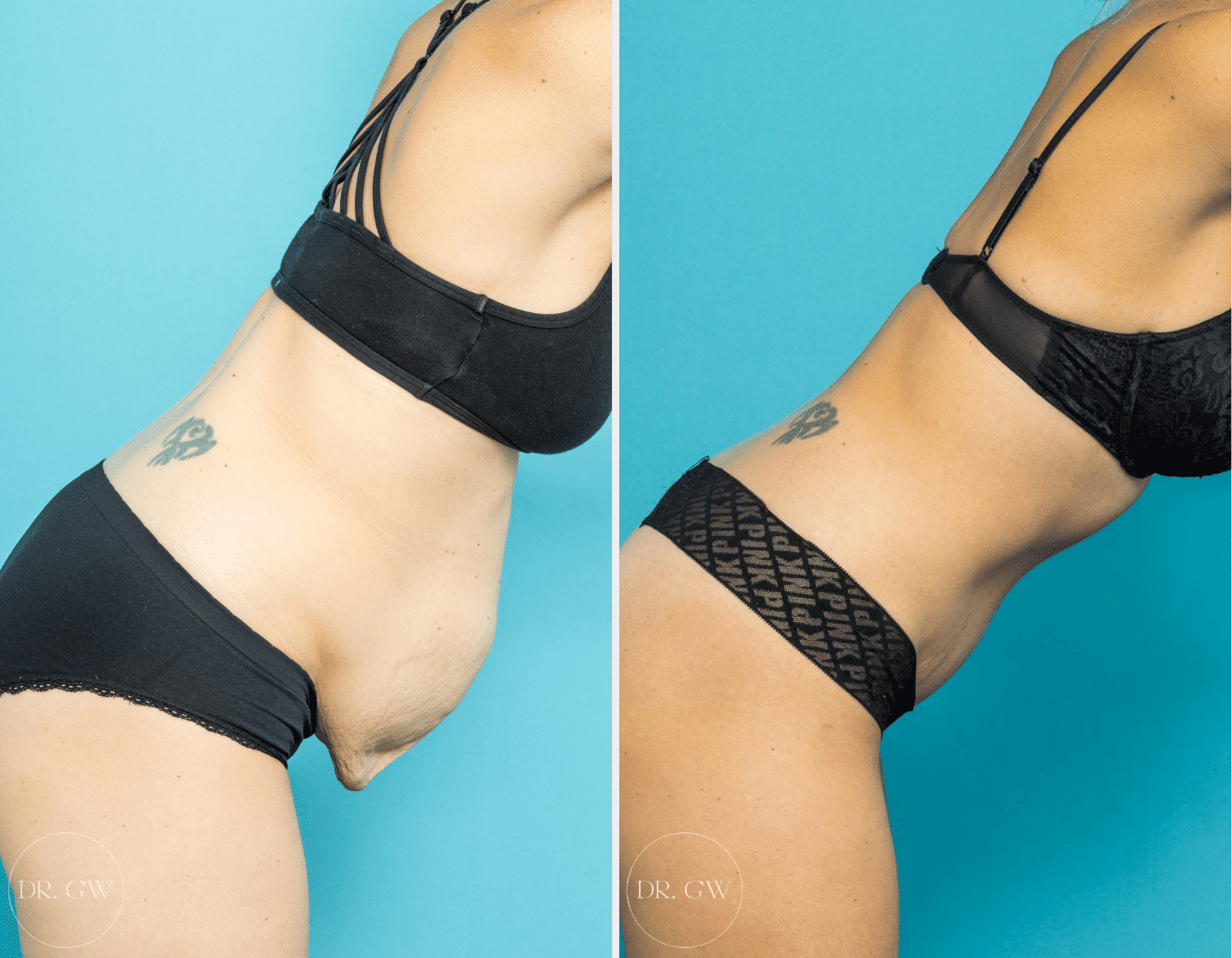
03 Aug Belly Bulge After Baby: Is It Diastasis Recti, Abdominal Fat, or Both?
What Causes a Post-Baby Belly Bulge?
Pregnancy is associated with physical changes in a woman’s body. While some of these changes may fade with time, others can persist. One such concern faced by many new mothers is the post-baby belly bulge. It can be attributed to two primary factors: diastasis recti and abdominal fat. In this blog we will discuss possible causes of the post-baby belly bulge and surgical and non-surgical options to correct both diastasis recti and abdominal fat.
Perth Specialist Plastic Surgeon Dr Guy Watts has many years of experience performing body and facial procedures to help patients achieve their goals.
Changes that Occur at the Level of the Abdominal Wall during Pregnancy
During pregnancy, significant changes occur at the level of the abdominal wall to accommodate the growing foetus and support the mother’s changing body. These changes are essential for the healthy development of the baby and the overall pregnancy experience. Let’s explore the changes that take place in the abdominal wall during pregnancy.
Stretching of the Abdominal Muscles
As the pregnancy progresses, the uterus expands to accommodate the growing baby. This expansion exerts pressure on the abdominal muscles, causing them to stretch. The rectus abdominis muscles, which are the paired muscles that run vertically along the midline of the abdomen, experience the most significant stretching.
Weakening of the Connective Tissue
Along with muscle stretching, the connective tissue known as the linea alba undergoes changes. The linea alba is a band of fibrous tissue that runs vertically down the midline of the abdomen, connecting the rectus abdominis muscles. Hormonal changes during pregnancy, particularly the hormone relaxin, cause the connective tissue to soften and become more pliable.
Separation of the Abdominal Muscles
The combination of muscle stretching and weakened connective tissue can lead to a condition known as diastasis recti. Diastasis recti refers to the separation of the rectus abdominis muscles along the midline of the abdomen. This separation creates a gap between the muscles, resulting in a visible bulge or ridge in the abdominal area.
Increased Blood Flow and Vascularisation
During pregnancy, there is an increased demand for blood supply to support the developing foetus. As a result, the abdominal wall experiences increased blood flow and vascularisation. This heightened blood circulation ensures an adequate oxygen and nutrient supply to the growing uterus and the surrounding abdominal structures.
Changes in Skin Elasticity
The expanding abdomen during pregnancy causes the skin to stretch as well. Hormonal changes, such as increased levels of oestrogen, can affect the elasticity of the skin. While some women may experience minimal stretch marks or skin discolouration, others may notice more noticeable changes in the skin’s appearance and texture.
Altered Posture and Alignment
As the abdominal wall undergoes changes, the body’s centre of gravity shifts due to the growing baby. This can lead to alterations in posture and spinal alignment. Some pregnant women can experience an increase in the curvature of the lower back (lordosis) to accommodate the forward shift of the abdomen.
Causes of the Post-Baby Belly Bulge
After giving birth, many women notice a protruding belly that doesn’t seem to go away despite their efforts. This post-baby belly bulge can be frustrating. There could be several causes, including diastasis recti and an accumulation of abdominal fat.
1. Diastasis Recti
Diastasis recti refers to the separation of the abdominal muscles that occurs during pregnancy. It happens when the connective tissue between the rectus abdominis muscles, known as the linea alba, stretches and weakens, causing the muscles to separate. This separation results in a noticeable bulge in the midsection.
How Diastasis Recti Occurs During Pregnancy
The growing uterus puts immense pressure on the abdominal muscles during pregnancy. Over time, this pressure combined with hormonal changes causes the linea alba to stretch and weaken. As a result, the rectus abdominis muscles separate, leading to diastasis recti.
Risk Factors for Developing Diastasis Recti
Certain factors increase the likelihood of developing diastasis recti. These include multiple pregnancies, carrying twins or multiples, giving birth to a large baby, advanced maternal age, and weak core muscles before pregnancy. Women who have had previous pregnancies are also more prone to diastasis recti.
Symptoms and Signs of Diastasis Recti
Diastasis recti can present various symptoms and signs, including a visible bulge or ridge along the midline of the abdomen when performing certain movements, such as sitting up or doing a crunch. Other symptoms may include lower back pain, poor posture, and difficulty engaging the core muscles.
2. Abdominal Fat
Hormonal changes during pregnancy can affect fat distribution in the body. The increase in oestrogen and progesterone levels can lead to an accumulation of fat in the abdominal region. This excess fat can contribute to the post-baby belly bulge.
Lifestyle Factors Influencing Abdominal Fat Gain
Apart from hormonal changes, lifestyle factors also play a significant role in the accumulation of abdominal fat. Lack of exercise, poor dietary choices, stress, and inadequate sleep can contribute to excess fat storage in the midsection.
Subcutaneous Fat vs. Visceral Fat
It’s important to differentiate between subcutaneous and visceral fat. Subcutaneous fat lies just beneath the skin, while visceral fat surrounds internal organs. Visceral fat is considered more harmful as it increases the risk of various health conditions, including heart disease and type 2 diabetes.
Health Risks Associated with Excess Abdominal Fat
Excess abdominal fat is not only a cosmetic concern but also poses health risks. It is associated with an increased likelihood of developing cardiovascular diseases, insulin resistance, metabolic syndrome, and other obesity-related conditions. Addressing abdominal fat is crucial for both appearance and overall well-being.
Options to Correct Post-Baby Belly Bulge
Non-Surgical Interventions
Before considering surgical options, non-surgical interventions should be explored. These may include physical therapy, core strengthening exercises, and wearing specialised abdominal binders. While these approaches can help improve muscle tone and provide temporary support, they may not fully resolve the post-baby belly bulge.
Tummy Tuck (Abdominoplasty) Procedure
A tummy tuck, also known as Abdominoplasty, is a surgical procedure that can effectively address diastasis recti and remove excess skin and fat from the abdominal area. During the procedure, Dr Watts repairs the separated abdominal muscles and removes any excess tissue, resulting in a flatter and firmer abdomen.
Liposuction for Targeted Fat Removal
Liposuction is another surgical option that can be used to target and remove excess fat deposits in specific areas, including the abdomen. It involves the insertion of a thin tube, called a cannula, to suction out the unwanted, stubborn fat. Liposuction can be performed in conjunction with other procedures, such as a tummy tuck/ abdominoplasty, for optimal results.
Multiple Procedures
In some cases, combining diastasis recti repair with cosmetic procedures like liposuction or a tummy tuck/ abdominoplasty can provide comprehensive results. This approach allows for the correction of both muscle separation and excess fat, leading to a more sculpted and toned abdomen.
Non-Surgical Approaches to Reduce Post-Baby Belly Bulge
Core Strengthening Exercises and Physical Therapy
Non-surgical approaches to address the post-baby belly bulge include core strengthening exercises and physical therapy. These focus on reactivating and strengthening the abdominal muscles, including the transverse abdominis, obliques, and pelvic floor muscles. Physical therapy can provide personalised guidance and techniques to aid in recovery.
Incorporating a Healthy Diet and Regular Exercise
A healthy diet and regular exercise are crucial in reducing abdominal fat and achieving a flatter stomach. Get more whole, nutrient-dense foods in your diet, and incorporate cardio and strength-training exercises into your routine. This combination helps burn calories, promote fat loss, and improve overall body composition.
Specialised Postpartum Workouts
Specialised postpartum workouts, such as postnatal yoga or Pilates, can target the specific needs and challenges of women after childbirth. These workouts focus on core strength, flexibility, and pelvic floor reconditioning. They provide a safe and effective way to address the post-baby belly bulge.
FAQs about Diastasis Recti and Abdominal Fat
Can diastasis recti resolve on its own without surgery?
- While some cases of diastasis recti may improve on their own, especially with appropriate exercises and physical therapy, more severe cases often require surgical intervention for a complete resolution.
- It is advisable to consult with Dr Watts as he can assess your specific condition and recommend the most suitable treatment approach.
Is it possible to eliminate post-baby belly bulge through diet alone?
- Diet plays a crucial role in overall weight management and reducing body fat, including abdominal fat. However, solely relying on diet to eliminate post-baby belly bulge may not be sufficient, especially if diastasis recti is also present.
- Combining a healthy, balanced diet with targeted exercises and potentially surgical options can yield more comprehensive and effective results.
How long does it take to recover from a Tummy Tuck/ Abdominoplasty procedure?
- The recovery period after an Abdominoplasty procedure varies from person to person, depending on factors such as the extent of the surgery and individual healing capabilities. Generally, it can take several weeks to a few months to fully recover.
Are there any risks or complications associated with Liposuction?
- Like any surgical procedure, Liposuction is associated with certain risks and potential complications. These can include infection, bleeding, adverse reactions to anaesthesia, irregular contours, and changes in skin sensation.
- You will discuss potential risks and complications with Dr Watts during the initial consultation. He will assess your suitability for the procedure.
Is it safe to start exercising immediately after giving birth?
- The timeline for resuming exercise after giving birth depends on various factors, including the type of delivery, any complications during pregnancy or childbirth, and individual recovery.
- It is generally recommended to wait until the body has had sufficient time to heal, usually around six weeks postpartum.
Further Reading about Body Procedures with Dr Watts
- Read Dr Watts’ Post Pregnancy Surgery Page
- Read Dr Watts’ Recovery after Post Pregnancy Surgery
- Read Dr Watts’ Exercise after Post Pregnancy Surgery
- Read Dr Watts’ Tummy Tuck (Abdominoplasty) Surgery Page
- Read Dr Watts’ Thigh Lift Surgery Page
- Read Dr Watts’ Body Lift Surgery Page
- Read Dr Watts’ How to Tell If Your Abdominal Muscles Were Damaged or Torn During Pregnancy
Medical References about Diastasis Recti and Abdominal Fat
Dr. Guy Watts – Specialist Plastic Surgeon In Perth WA
Dr. Guy Watts (AHPRA Medical Reg. MED0001539378) is a Specialist Plastic Surgeon with an extensive career that spans across renowned plastic surgery clinics worldwide. His exceptional expertise has been honed through invaluable experiences at esteemed establishments such as the prestigious New York Eye and Ear Infirmary and the renowned Pitanguy Clinic in Brazil.
Having collaborated with the foremost cosmetic plastic surgeons on a global scale, Dr. Watts has chosen to return to Perth after a remarkable 17-year journey of intensive training and invaluable professional experience to bring the latest practices and technology in cosmetic plastic surgery to his patients.
Dr. Watts is a Fellow of the Royal College of Surgeons (FRACS) and a Member of the Australian Society of Plastic Surgeons (ASPS), Australasian Society of Aesthetic Plastic Surgeons (ASAPS) and the International Society of Aesthetic Plastic Surgeons (ISAPS).







